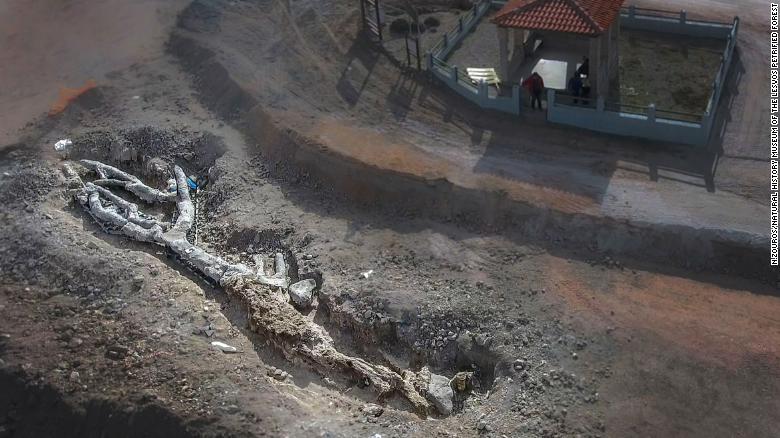
A couple of weeks ago I became captivated with news coming from the Greek Island of Lesbos of a tree found petrified in lava and ash. This was a complete tree with roots, trunk, branches, and even a few leaves found all together, and this was the first time such a complete tree was found. Although it’s unclear if the leaves were from this or a different tree. According to Reuters, animal bones were also found in the vicinity.
This is just the latest discovery from ongoing excavations in Lesbos. Roughly 17 to 20 million years ago, volcanic eruptions coated the island in thick layers of ash and lava that, when combined with rain, created the perfect slurry to preserve a forest.
This new tree appears to be from roughly 20 million years ago, and researchers from the Natural History Museum of the Lesvos Petrified Forest are looking forward to studying the tree to learn what it was and to learn more about the ancient climate of this island. While this is the most complete tree so far uncovered, it is part of an entire ecosystem that has been preserved. In 2015, UNESCO made this site a Global Geopark, and it is a proposed World Heritage Site. The trees and petrified foliage that have been found here include a diversity of fruit trees, conifers, and more that point to this island once having a subtropical climate that is very different from what we see today.

Finding things preserved in lava isn’t new. The Italian cities of Pompeii and Herculaneum both host impressive archaeological sites where ancient cities were preserved by an eruption of Mount Vesuvius in the year 79, and someday, future archaeologists will be digging up a Mexican village buried in lava in 1943, leaving only the upper levels of a church still visible.
Looking around our solar system, volcanism isn’t all that unusual. Most commonly, cryovolcanoes are erupting with ice, kind of all over the place, but I don’t think those are capable of the same awesome petrification we keep finding on Earth. Io has regular old lava-spewing volcanoes, but its surface is getting resurfaced a bit too fast for there to be much hope of safely exploring what might be preserved there. But Mars… I’d like to point out that Mars has an amazing array of lava fields that in many cases were formed in the years after Mars was capable of supporting life.
Right now, the Perseverance rover is on Mars looking for regular old fossil evidence of past life on Mars. This could be stromatolites or chemical signatures left behind in the rocks it will someday sample. To be clear, Percy isn’t going to go digging in lava. That’s not its job, and it doesn’t have the right tools and power.
But one day, there might be the ability to go looking for petrified life on Mars, and the petrified forest of Lesbos along with the cities of Herculaneum and Pompeii tell where to look: the best preservation appears tied to pyroclastic flows, which are rivers of ash, gas, and other volcanic matter that can sweep down a volcano at 60 to 400 mph! This fast-moving material can flash preserve anything it encases, including both humans and trees and just about anything else.
If we can find what looks like a nicely preserved pyroclastic flow deposit dating back to when Mars was wet and warmer, who knows what might be preserved. Moss? Lichens? I can’t imagine anything more complicated, but who am I to guess at what the universe might have allowed to form that we might one day be able to find.
More Information
Natural History Museum of the Lesvos Petrified Forest press release (Greek)
CNN article




 Join the Crew!
Join the Crew!
 Escape Velocity Space News
Escape Velocity Space News
0 Comments